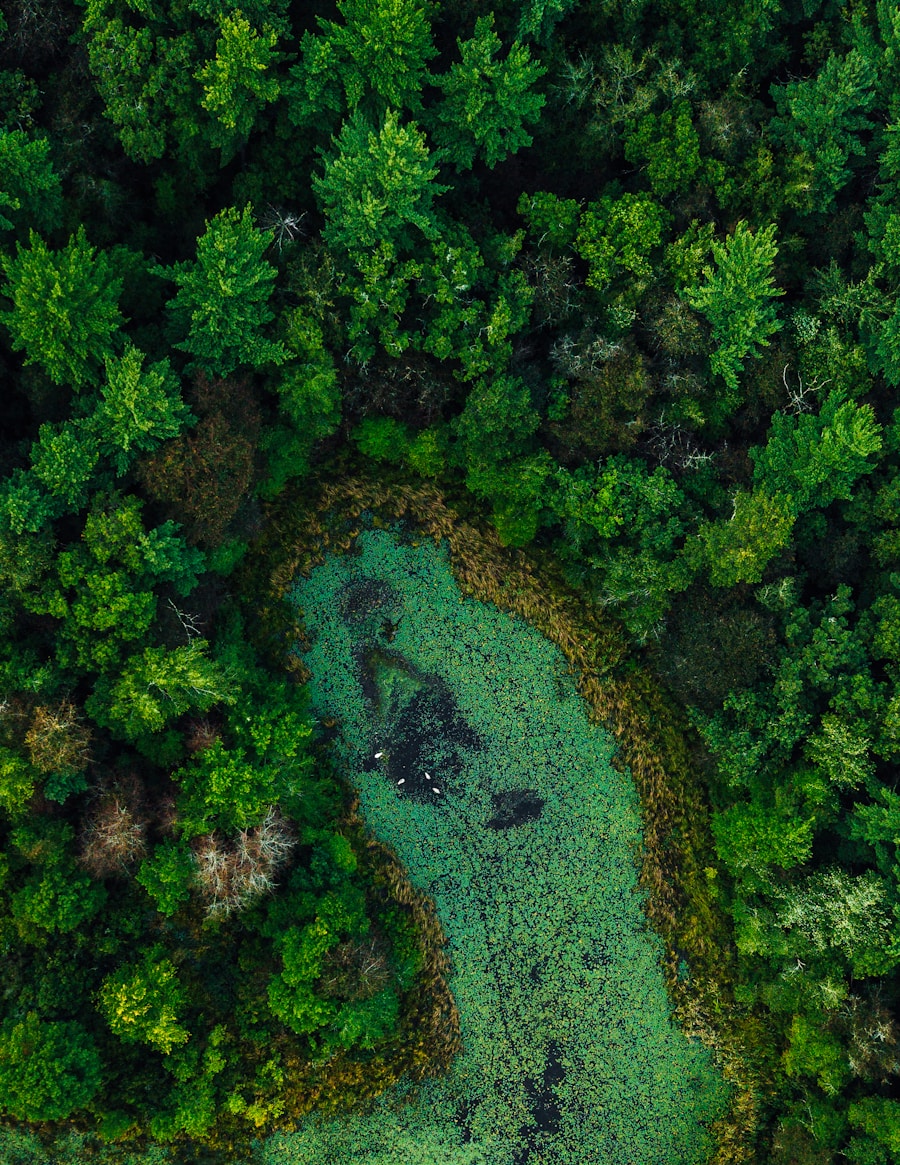The intersection of artificial intelligence (AI) and biodiversity restoration represents a burgeoning field that holds significant promise for addressing the pressing challenges of environmental degradation and species extinction. As the global community grapples with the consequences of climate change, habitat loss, and pollution, innovative solutions are urgently needed to restore ecosystems and preserve biodiversity. AI, with its capacity for processing vast amounts of data and identifying patterns, offers a transformative approach to conservation efforts.
By harnessing machine learning algorithms, remote sensing technologies, and predictive analytics, researchers and conservationists can gain insights that were previously unattainable, enabling more effective strategies for restoring ecosystems. Biodiversity restoration is not merely an ecological endeavor; it is a multifaceted challenge that encompasses social, economic, and ethical dimensions. The decline in biodiversity has far-reaching implications for human well-being, as ecosystems provide essential services such as clean air and water, pollination of crops, and climate regulation.
In this context, AI serves as a powerful tool that can enhance our understanding of complex ecological systems and facilitate the development of targeted interventions. By integrating AI into biodiversity restoration initiatives, stakeholders can optimize resource allocation, monitor ecosystem health, and engage communities in conservation efforts more effectively.
Key Takeaways
- AI has the potential to revolutionize biodiversity restoration by providing innovative solutions to complex ecological challenges.
- Current challenges in biodiversity conservation include habitat destruction, invasive species, climate change, and overexploitation of natural resources.
- AI applications in biodiversity restoration include species identification, habitat mapping, and predictive modeling for conservation planning.
- Monitoring and data collection using AI can improve the efficiency and accuracy of ecological surveys and help in tracking changes in biodiversity over time.
- AI can play a crucial role in ecosystem restoration and management by optimizing resource allocation and identifying potential areas for restoration efforts.
Current Challenges in Biodiversity Conservation
The current landscape of biodiversity conservation is fraught with challenges that hinder effective restoration efforts. One of the most pressing issues is habitat destruction, driven primarily by urbanization, agriculture, and industrial activities. As natural habitats are fragmented or entirely removed, species face increased competition for resources, leading to population declines and extinctions.
The loss of biodiversity not only disrupts ecological balance but also diminishes the resilience of ecosystems to adapt to changing environmental conditions. This situation is exacerbated by climate change, which alters habitats and threatens species that are unable to adapt quickly enough. Another significant challenge is the lack of comprehensive data on species populations and distributions.
Traditional methods of data collection, such as field surveys and manual monitoring, are often labor-intensive and time-consuming. Consequently, many regions remain under-surveyed, leading to gaps in knowledge that hinder effective conservation planning. Additionally, the complexity of ecological interactions makes it difficult to predict how changes in one species or habitat will affect others.
This uncertainty complicates decision-making processes for conservationists who must prioritize actions based on limited information.
AI Applications in Biodiversity Restoration

AI applications in biodiversity restoration are diverse and innovative, offering new avenues for enhancing conservation efforts. One prominent application is the use of machine learning algorithms to analyze large datasets collected from various sources, including satellite imagery, drone surveys, and citizen science contributions. For instance, researchers have employed convolutional neural networks (CNNs) to identify species from images captured in the wild.
This technology not only accelerates the identification process but also increases the accuracy of species monitoring, allowing conservationists to track population trends more effectively. Another significant application of AI is in predictive modeling, where algorithms analyze historical data to forecast future ecological changes.
For example, AI-driven models have been used to predict the impacts of climate change on specific habitats, enabling proactive measures to protect vulnerable species before they reach critical thresholds. This forward-thinking approach is essential in a rapidly changing world where timely interventions can mean the difference between survival and extinction for many species.
Monitoring and Data Collection Using AI
Monitoring ecosystems and collecting data on biodiversity are critical components of effective conservation strategies. AI technologies have revolutionized these processes by providing tools that enhance efficiency and accuracy. Remote sensing technologies powered by AI can analyze satellite images to detect changes in land use, vegetation cover, and habitat fragmentation over time.
This capability allows conservationists to monitor large areas without the need for extensive fieldwork, which can be logistically challenging and costly. Moreover, AI-driven tools such as acoustic monitoring systems can capture sounds from ecosystems to identify species presence and behavior. For example, bioacoustic sensors can record bird calls or amphibian croaks, which can then be analyzed using machine learning algorithms to determine species diversity in a given area.
This method not only provides valuable data on species populations but also allows for real-time monitoring of ecosystem health. By integrating these advanced monitoring techniques into biodiversity restoration projects, stakeholders can make data-driven decisions that enhance the effectiveness of their interventions.
AI in Ecosystem Restoration and Management
The application of AI in ecosystem restoration extends beyond monitoring; it plays a crucial role in the management and rehabilitation of degraded environments. One notable example is the use of AI algorithms to optimize reforestation efforts. By analyzing environmental data such as soil quality, climate conditions, and existing vegetation patterns, AI can identify the most suitable tree species for planting in specific locations.
This targeted approach increases the likelihood of successful reforestation by ensuring that chosen species are well-adapted to their new environment. Additionally, AI can assist in managing invasive species that threaten native biodiversity. Machine learning models can analyze patterns of invasion and predict potential spread based on environmental factors.
This information enables conservationists to implement timely control measures before invasive species become entrenched in an ecosystem. For instance, AI has been used to track the spread of invasive plants through satellite imagery analysis, allowing for rapid response efforts that protect native flora and fauna.
Ethical Considerations and Risks of AI in Biodiversity Restoration

While the integration of AI into biodiversity restoration offers numerous benefits, it also raises important ethical considerations and potential risks that must be addressed. One primary concern is the reliance on technology over traditional ecological knowledge. Indigenous communities and local stakeholders often possess invaluable insights into their environments that may not be captured by AI systems.
It is crucial to ensure that these voices are included in decision-making processes to avoid perpetuating inequities or overlooking critical ecological wisdom. Moreover, there are risks associated with data privacy and security when utilizing AI technologies for biodiversity monitoring. The collection of large datasets may inadvertently expose sensitive information about endangered species or critical habitats to poachers or developers.
Conservationists must implement robust data management practices that prioritize confidentiality while still allowing for meaningful analysis. Striking a balance between technological advancement and ethical responsibility is essential for fostering trust among stakeholders involved in biodiversity restoration efforts.
Collaborations and Partnerships in AI and Biodiversity Restoration
The complexity of biodiversity restoration necessitates collaboration among various stakeholders, including governments, non-governmental organizations (NGOs), academic institutions, and private sector entities.
For example, collaborations between tech companies specializing in AI and conservation organizations can lead to the development of innovative tools tailored specifically for biodiversity monitoring and management.
One successful partnership model involves citizen science initiatives that engage local communities in data collection using mobile applications powered by AI algorithms. These platforms allow individuals to contribute observations about local wildlife or environmental changes while simultaneously building a sense of stewardship within their communities. By fostering collaboration between technology developers and grassroots organizations, these partnerships can create a more inclusive approach to biodiversity restoration that empowers local stakeholders.
Future Outlook and Potential Impact of AI in Biodiversity Restoration
Looking ahead, the potential impact of AI on biodiversity restoration is immense. As technology continues to evolve, we can expect even more sophisticated applications that enhance our understanding of ecosystems and improve restoration outcomes. For instance, advancements in natural language processing may enable AI systems to analyze scientific literature more effectively, synthesizing knowledge from diverse sources to inform conservation strategies.
Furthermore, as global awareness of biodiversity loss grows, there is an increasing demand for innovative solutions that integrate technology with traditional conservation practices. The future may see a greater emphasis on interdisciplinary approaches that combine ecological science with data analytics, social sciences, and community engagement strategies. By embracing this holistic perspective, stakeholders can develop comprehensive restoration plans that address both ecological needs and human aspirations.
In conclusion, the integration of AI into biodiversity restoration efforts represents a transformative opportunity to enhance conservation outcomes in an era marked by unprecedented environmental challenges. By leveraging advanced technologies while remaining mindful of ethical considerations and fostering collaborative partnerships, we can pave the way for a more sustainable future where biodiversity thrives alongside human development.
In a recent article discussing The Future of AI in Restoring Biodiversity and Ecosystems, it is interesting to note how technology is being utilized to address environmental challenges. One related article that caught my attention is

